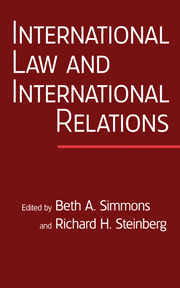Book contents
- Frontmatter
- Contents
- Contributors
- Abstracts
- Preface
- Editors' Note
- PART I INTERNATIONAL REGIMES THEORY: DOES LAW MATTER?
- PART II COMMITMENT AND COMPLIANCE
- PART III LEGALIZATION AND ITS LIMITS
- PART IV INTERNATIONAL LAW AND INTERNATIONAL NORMS
- PART V TREATY DESIGN AND DYNAMICS
- PART VI LAW AND LEGAL INSTITUTIONS
- 18 Europe Before the Court: A Political Theory of Legal Integration (1993)
- 19 The European Court of Justice, National Governments, and Legal Integration in the European Union (1998)
- PART VII OTHER SUBSTANTIVE AREAS OF INTERNATIONAL LAW
- References
- Index
18 - Europe Before the Court: A Political Theory of Legal Integration (1993)
Published online by Cambridge University Press: 05 June 2012
- Frontmatter
- Contents
- Contributors
- Abstracts
- Preface
- Editors' Note
- PART I INTERNATIONAL REGIMES THEORY: DOES LAW MATTER?
- PART II COMMITMENT AND COMPLIANCE
- PART III LEGALIZATION AND ITS LIMITS
- PART IV INTERNATIONAL LAW AND INTERNATIONAL NORMS
- PART V TREATY DESIGN AND DYNAMICS
- PART VI LAW AND LEGAL INSTITUTIONS
- 18 Europe Before the Court: A Political Theory of Legal Integration (1993)
- 19 The European Court of Justice, National Governments, and Legal Integration in the European Union (1998)
- PART VII OTHER SUBSTANTIVE AREAS OF INTERNATIONAL LAW
- References
- Index
Summary
European integration, a project deemed politically dead and academically moribund for much of the past two decades, has reemerged as one of the most important and interesting phenomena of the 1990s. The pundits are quick to observe that the widely touted “political and economic integration of Europe” is actually neither, that the “1992” program to achieve the single market is but the fulfillment of the basic goals laid down in the Treaty of Rome in 1958, and that the program agreed on for European monetary union at the Maastricht Intergovernmental Conference provides more ways to escape monetary union than to achieve it. Nevertheless, the “uniting of Europe” continues. Even the self-professed legion of skeptics about the European Community (EC) has had to recognize that if the community remains something well short of a federal state, it also has become something far more than an international organization of independent sovereigns.
An unsung hero of this unexpected twist in the plot appears to be the European Court of Justice (ECJ). By their own account, now confirmed by both scholars and politicians, the thirteen judges quietly working in Luxembourg managed to transform the Treaty of Rome (hereafter referred to as “the treaty”) into a constitution. They thereby laid the legal foundation for an integrated European economy and polity. Until 1963 the enforcement of the Rome treaty, like that of any other international treaty, depended entirely on action by the national legislatures of the member states of the community.
- Type
- Chapter
- Information
- International Law and International RelationsAn International Organization Reader, pp. 457 - 485Publisher: Cambridge University PressPrint publication year: 2007



